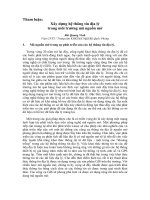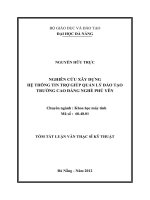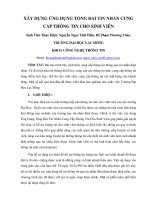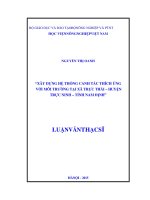Designing Databases (XÂY DỰNG ỨNG DỤNG HỆ THỐNG THÔNG TIN SLIDE)
Bạn đang xem bản rút gọn của tài liệu. Xem và tải ngay bản đầy đủ của tài liệu tại đây (1.1 MB, 56 trang )
13
Chapter 13:
Designing Databases
Systems Analysis and Design in a Changing
World, 3rd Edition
13
Learning Objectives
Describe the differences and similarities between
relational and object-oriented database
management systems
Design a relational database schema based on
an entity-relationship diagram
Design an object database schema based on a
class diagram
Systems Analysis and Design in a Changing World, 3 rd Edition
2
13
Learning Objectives (continued)
Design a relational schema to implement a hybrid
object-relational database
Describe the different architectural models for
distributed databases
Systems Analysis and Design in a Changing World, 3 rd Edition
3
13
Overview
This chapter describes design of relational and
OO data models
Developers transform conceptual data models
into detailed database models
Entity-relationship diagrams (ERDs) for traditional
analysis
Class diagrams for object-oriented (OO) analysis
Detailed database models are implemented with
database management system (DBMS)
Systems Analysis and Design in a Changing World, 3 rd Edition
4
Databases and Database
Management Systems
13
Databases (DB) – integrated collections of stored
data that are centrally managed and controlled
Database management system (DBMS) – system
software that manages and controls access to
database
Databases described by a schema: description of
structure, content, and access controls
Systems Analysis and Design in a Changing World, 3 rd Edition
5
13
Components of a DB and DBMS
Systems Analysis and Design in a Changing World, 3 rd Edition
6
13
DBMS Important Capabilities
Simultaneous access by multiple users and
applications
Access to data without application programs (via
a query language)
Managing organizational data with uniform
access and content controls
Systems Analysis and Design in a Changing World, 3 rd Edition
7
13
Database Models
Impacted by technology changes since 1960s
Model Types
Hierarchical
Network
Relational
Object-oriented
Most current systems use relational or objectoriented data models
Systems Analysis and Design in a Changing World, 3 rd Edition
8
13
Relational Databases
Relational database management system
(RDBMS) organizes data into tables or relations
Tables are two dimensional data structures
Tuples: rows or records
Fields: columns or attributes
Tables have primary key field(s) which can be
used to identify unique records
Keys relate tables to each other
Systems Analysis and Design in a Changing World, 3 rd Edition
9
Partial Display of Relational Database
Table
Systems Analysis and Design in a Changing World, 3 rd Edition
13
10
13
Designing Relational Databases
Create table for each entity type
Choose or invent primary key for each table
Add foreign keys to represent one-to-many
relationships
Create new tables to represent many-to-many
relationships
Systems Analysis and Design in a Changing World, 3 rd Edition
11
13
Designing Relational Databases (continued)
Define referential integrity constraints
Evaluate schema quality and make necessary
improvements
Choose appropriate data types and value
restrictions (if necessary) for each field
Systems Analysis and Design in a Changing World, 3 rd Edition
12
13
Relationship Between Data in Two Tables
Systems Analysis and Design in a Changing World, 3 rd Edition
13
13
RMO Entity-Relationship Diagram
Systems Analysis and Design in a Changing World, 3 rd Edition
14
13
Representing Relationships
Relational databases use foreign keys to
represent relationships
One-to-many relationship
Add primary key field of ‘one’ entity type as foreign
key in table that represents ‘many’ entity type
Many-to-many relationship
Use the primary key field(s) of both entity types
Use (or create) an associate entity table to
represent relationship
Systems Analysis and Design in a Changing World, 3 rd Edition
15
13
Entity Tables with Primary Keys
Systems Analysis and Design in a Changing World, 3 rd Edition
16
13
Represent One-to-Many Relationships
Systems Analysis and Design in a Changing World, 3 rd Edition
17
13
Enforcing Referential Integrity
Consistent relational database state
Every foreign key also exists as a primary key
value
DBMS enforces referential integrity automatically
once schema designer identifies primary and
foreign keys
Systems Analysis and Design in a Changing World, 3 rd Edition
18
13
DBMS Referential Integrity Enforcement
When rows containing foreign keys are created:
When row is deleted:
DBMS ensures that value also exists as a primary
key in a related table
DBMS ensures no foreign key in related tables
have same value as primary key of deleted row
When primary key value is changed:
DBMS ensures no foreign key values in related
tables contain the same value
Systems Analysis and Design in a Changing World, 3 rd Edition
19
13
Evaluating Schema Quality
High quality data model has:
Uniqueness of table rows and primary keys
Ease of implementing future data model changes
(flexibility and maintainability)
Lack of redundant data (database normalization)
Database design is not objective or quantitatively
measured; it is experience and judgment based
Systems Analysis and Design in a Changing World, 3 rd Edition
20
13
Database Normalization
Normal forms minimize data redundancy
First normal form (1NF) – no repeating fields or
groups of fields
Functional dependency – one-to-one relationship
between the values of two fields
2NF – in 1NF and if each non-key element is
functionally dependent on entire primary key
3NF – in 2NF and if no non-key element is
functionally dependent on any other non-key
element
Systems Analysis and Design in a Changing World, 3 rd Edition
21
Decomposition of 1NF Table into 2NF
Tables
Systems Analysis and Design in a Changing World, 3 rd Edition
13
22
13
Conversion of 2NF Table into 3NF Tables
Systems Analysis and Design in a Changing World, 3 rd Edition
23
13
Object-Oriented Databases
Direct extension of OO design and programming
paradigm
ODBMS stores data as objects or classes
Direct support for method storage, inheritance,
nested objects, object linking, and programmerdefined data types
Object definition language (ODL)
Standard language for describing structure and
content of an object database
Systems Analysis and Design in a Changing World, 3 rd Edition
24
13
Designing Object Databases
Determine which classes require persistent
storage
Define persistent classes
Represent relationships among persistent classes
Choose appropriate data types and value
restrictions (if necessary) for each field
Systems Analysis and Design in a Changing World, 3 rd Edition
25


![[Khóa luận]thiết kế và xây dựng hệ thống tín hiệu đèn giao thông nút giao thông lê hồng phong và nguyễn bỉnh khiêm dùng PLC](https://media.store123doc.com/images/document/13/ce/jj/medium_iEXM7MKsu1.jpg)






